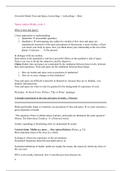Summary
Summary Lectures Seminars - Media, Time and Space
- Course
- Institution
This document contains all the notes from the lectures and seminars of Media, Time and Space. It contains the information from the slides, information about the weekly viewings and the extra notes addressed by the teacher. My final grade for the exam was an 9,8 /10.
[Show more]



